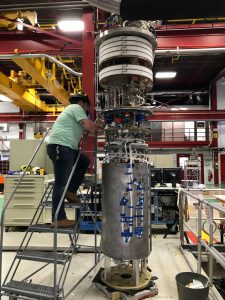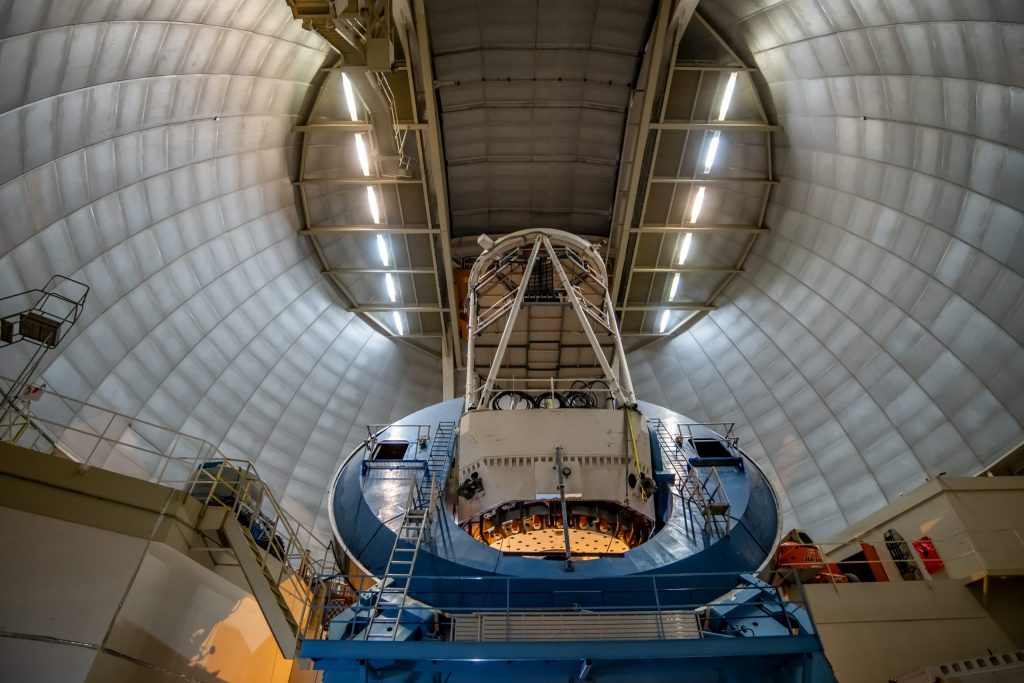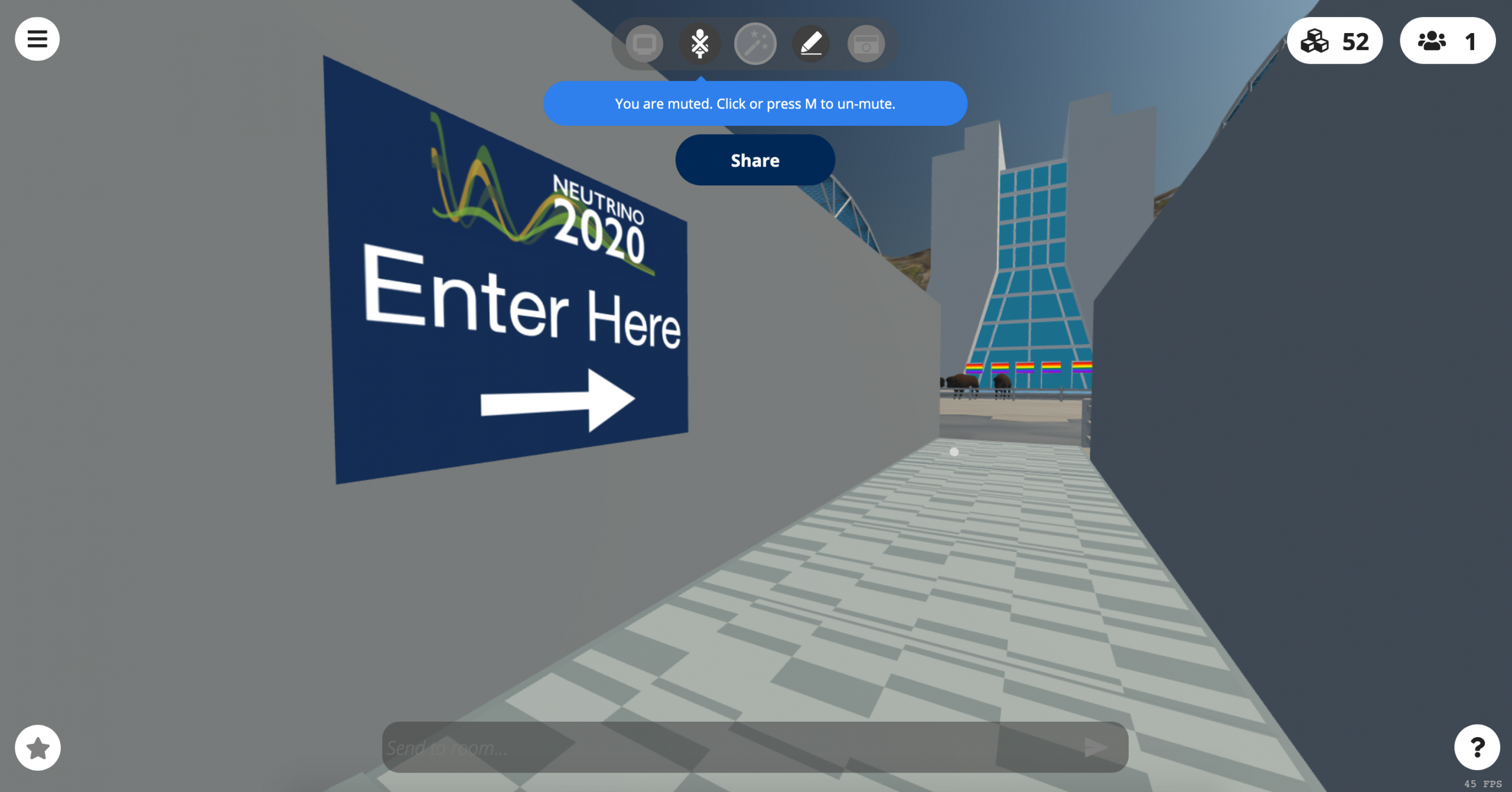Physics poster sessions: a heady mix of science, networking and robots. That last one isn’t so common at in-person science conferences, but it was a regular sight at the recently concluded Neutrino 2020 conference, where virtual reality poster sessions hosted thousands of robotic avatars belonging to particle physicists from around the world. While most walked through the virtual world as a robot in vaguely human clothing, others donned panda suits, uploaded custom skins with gigantic human heads or particle tracks or – in one case – turned themselves into a jar of Jif peanut butter.
“It’s both more weird and more fun than I expected,” said Diana Parno, a physicist at Carnegie Mellon University who presented in one of the virtual poster sessions. “And one of the nice things about poster sessions is meeting with new people and colleagues, and making introductions – and we’ve still been able to do that.”
The 29th International Conference on Neutrino Physics is the largest gathering of neutrino scientists in the world. This year the conference was hosted jointly by the Department of Energy’s Fermilab and the University of Minnesota and, for the first time, held entirely online. The change brought many advantages to the conference. Notably, more than 3,400 people from 67 countries and covering all seven continents tuned in to the 79 talks – more than four times the typical number of attendees. (Almost half of attendees were early in their career, identifying as undergraduate or graduate students.) Instead of full days of talks, half-days were spread over two weeks, allowing greater involvement from participants in different time zones. Going virtual also meant some individuals with monetary restrictions, travel restrictions, or obligations at home or work could participate.
“What we really wanted from this platform is a way for people to interact with others as if they were in person,” said Marco Del Tutto, a Fermilab physicist who created the virtual poster sessions using open source software from Mozilla Hubs. “It’s hard to tell if this is going to work until you try. It made me proud when I went into a poster session and saw people explaining their poster to a crowd, or walking through a room and running into people.”
Over the course of four sessions, presenters showed off 532 posters on display in 30 different virtual reality rooms. (A standard list of posters and short videos from the presenters were also available on a webpage). While in-person posters are typically set up in one concentrated area, spreading the posters across virtual rooms gave avatars more space – and reduced the amount of bandwidth to run each interactive area. It also gave Del Tutto a chance to add a neutrino twist. Four different styles of room represented four different sources of neutrinos: Fermilab’s iconic bison and Wilson Hall were the backdrop for accelerator neutrinos, a nuclear power plant represented reactor neutrinos, an enormous sun hung low in the sky for solar neutrinos and an exploding star overhead for supernova neutrinos. To complete the conference vibe, there were tables, couches and cookies scattered around.
Participants could talk in real time, their avatars’ heads rapidly bouncing around. Directional sound in headphones gave a sense of where different people were in the room and allowed users to stumble upon conversations. Walking around, one overheard all the usual topics of discussion at a physics conference – results, experimental status, careers, life updates – as well as discussion of the oddities of virtual environment – the digital bison standing nearby, how to make your avatar wear a tuxedo, the underlying technology and the inevitable glitch here or there.
“It’s clearly the kind of thing that will get better and better,” said Kate Scholberg, a neutrino physicist at Duke University and a member of the International Advisory Committee for the conference. She also gathered together about 20 members of the COHERENT collaboration for an avatar group photo in Grant Park. “It’s different, and I think it’s been really fun. I’ve been having conversations with people, and it replicates many of the in-person aspects.”
Del Tutto and the organizers also set up social rooms for researchers to hang out and chat, as well as virtual tours of Fermilab locations and spots in downtown Chicago.
“The other part of a conference is that, if it’s really in Chicago, it’s a chance to see the city with your colleagues, get to know them better and improve your working relationship with them,” Del Tutto said.
Of course, virtual reality was not the only way to interact with colleagues. Attendees also connected through chat on a dedicated Neutrino 2020 Slack account. Organizers set up channels for subsets of neutrino research (such as sterile neutrinos or long-baseline neutrinos) where attendees could drop in additional questions for the speakers and discuss ideas from the talks. There were also specific channels for topics such as the future of conferences, posters, help from the organizers, virtual reality and job opportunities. The Neutrino 2020 Slack saw more than 23,000 messages over the two-week conference.
“We had to change our plans quickly and explore creative options for making the conference as interactive as possible,” said Tanaz Mohayai, a Fermilab neutrino physicist and the webpage lead for Neutrino 2020. “It’s been wonderful to see the excitement surrounding the latest results in our field, as well as the many meaningful conversations taking place on Slack and in the poster sessions in the virtual world.”
Many attendees expect to see the virtual reality and chat features of Neutrino 2020 replicated in future online physics conferences – but it may not stop there. As conferences return to having an in-person component, there’s potential to keep the best of what works from the online world. One can envision a hybrid conference that allows for participation from around the world, virtual interactions and greater discussion through chat. And maybe, just maybe, there will be people walking around poster sessions dressed as robots – or a jar of peanut butter.
The poster portal, videos and recordings of plenary talks will continue to be available online at the Neutrino 2020 website.
Neutrino research at Fermilab is supported by the DOE Office of Science
Fermilab is supported by the Office of Science of the U.S. Department of Energy. The Office of Science is the single largest supporter of basic research in the physical sciences in the United States and is working to address some of the most pressing challenges of our time. For more information, visit science.energy.gov.

A member of the Fermilab magnet team prepares the demonstrator accelerator magnet for testing in March 2020. These tests are an important step toward meeting the requirements of a future hadron collider under discussion in the particle physics community. Photo: Alexander Zlobin
The Fermilab magnet team has done it again. After setting a world record for an accelerator magnet in 2019, they have broken it a year later.
In a June 2020 test, a demonstrator magnet designed and built by the magnet team at the Department of Energy’s Fermilab achieved a 14.5-tesla field strength for an accelerator steering dipole magnet, surpassing their previous record of 14.1 T.
This test is an important step toward addressing the demanding magnet requirements of a future hadron collider under discussion in the particle physics community. If built, such a collider would be four times larger and almost eight times more powerful than the 17-mile-circumference Large Hadron Collider at the European laboratory CERN, which operates at a steering field of 7.8 T. Current future-collider designs estimate the field strength for a steering magnet — the magnet responsible for bending particle beams around a curve — to be up to 16 T.
“Our next goal is to break the ’15-tesla wall’ and advance the maximum field in accelerator steering magnets to 17 T and even above, significantly improve magnet quench performance and optimize cost,” said Fermilab scientist Alexander Zlobin, who leads the magnet project. “Reaching these goals will provide strong foundation for future high-energy colliders.”
Read more about the Fermilab-built future-collider steering magnet.
Research on accelerator magnets is supported by the Department of Energy Office of Science.
Fermilab is supported by the Office of Science of the U.S. Department of Energy. The Office of Science is the single largest supporter of basic research in the physical sciences in the United States and is working to address some of the most pressing challenges of our time. For more information, please visit energy.gov/science.
Since 2005, scientists have been scanning the night sky to create a three-dimensional map of our universe with the purpose of shedding light on one of the biggest mysteries in physics: the nature and identity of dark energy and dark matter. That effort is about to get a massive upgrade with the successful installation and testing of the Dark Energy Spectroscopic Instrument, or DESI.
Scientists recently installed DESI at the Kitt Peak National Observatory in Arizona. The device features 5,000 optical fibers, each one designed to collect light from a single galaxy. DESI is enabling scientists to gather 20 times more data than previous surveys.
A previous instrument on a different telescope, the Baryon Oscillation Spectroscopic Survey instrument, required collaborators to drill 1,000 holes into large metal plates that held fibers in a configuration that exactly matched the position of known galaxies in a small portion of the night sky. Each time scientists wanted to image new galaxies, a new plate had to be drilled and the fibers inserted by hand.
With DESI, researchers have relegated the grueling work of pinpointing galaxy locations to a hive of 5,000 robotic pencil-shaped tubes. The positioners have a precision of several micrometers — about one-10th the width of a human hair — and are capable of moving on their own to focus on distant galaxies.
Scientists can use these redshifted signals to create a three-dimensional map of our universe stretching back 11 billion years into its nascent past. By analyzing the distribution of galaxies through space and time, scientists can then make inferences about the nature of the unknown dark matter that pulls galaxies together and that of dark energy, which pushes them apart.
Researchers completed the first round of testing on the robotic positioners last November.
“I was pleased to see that positioners moved to where we told them to go when we turned on the instrument,” said Stephen Kent, a scientist at the Department of Energy’s Fermilab. “With a system this complex, you never know where you might run into problems.”
A second milestone was achieved in January when the positioners were accurately pointed at over 2,000 stars simultaneously.
“That was the moment we could begin working on science, not just engineering,” Kent said.
During this testing phase, researchers implemented a software package called Platemaker, which was designed by Kent and scientist Eric Neilsen at Fermilab.
The software is a key player in choreographing the movement of all 5,000 robotic positioners simultaneously, especially since the positioners can sometimes get in each other’s way.
“As a design decision for the instrument from the beginning, we allow the robots to reach into each other’s patrol zones,” said Joseph Silber, an engineer at Lawrence Berkeley National Laboratory and lead engineer on the focal plane. “That means they can collide, and they shouldn’t.”
Since then, Kent and his team have been fine-tuning the code in Platemaker to improve the accuracy to which the positioners can be located.
The software guides the robotic positioners on a multistep process to locate galaxies. First, the focal plane — a large metallic structure that holds the positioners in place — must be pointed at just the right portion of sky. Just as old maritime navigators would use the position of the stars to guide their way, 10 high-resolution cameras embedded in the focal plane capture and analyze light from stars, which allows researchers to orient the telescope.
These movements to position the focal plane have to be incredibly precise for each fiber to receive the most light that it can from its assigned galaxy. Nudged even a little off target, and the fiber will be only partially filled with its galaxy’s light. But when positioned as designed, each fiber will be filled completely with the light of its galaxy, with minimal background.
Once the telescope is pointed in the right direction, the robotic positioners begin an intricate mechanical waltz, peering deep into the sky to detect sources of light far too faint for human eyes to see.

Scientists have begun operating the Dark Energy Spectroscopic Instrument, or DESI, to create a 3-D map of over 30 million galaxies and quasars that will help them understand the nature of dark energy. Photo: Marilyn Sargent /Lawrence Berkeley National Laboratory
Their high degree of precision gets them most of the way to the desired galaxy, but the angle might still be slightly off for some. To get them the rest of the way, DESI has a CCD camera installed at the primary mirror of the telescope, which looks up at the focal plane. Researchers use a built-in light source to illuminate the fibers embedded in the robotic positioners. The fibers project the resulting small dots of light to the CCD camera, which then images them. The Platemaker software compares the positions of the fibers in the images to where they should actually be pointed based on detailed star charts from previous surveys.
The software then computes how far off each positioner is from the desired target, after which another system can move it the rest of the way toward its designated galaxy.
“It’s a very complicated modeling process, which has taken us a few years to figure out,” Kent said.
With the toughest work now complete, researchers, who are currently teleworking, plan to finish testing the software when they return to site.
DESI is scheduled to operate for a total of five years, during which time it will measure the redshifts of over 30 million galaxies and quasars — a type of massive black hole. Scientists can then use this information to determine if and how the concentration of dark energy has changed throughout the history of our universe.
Work for DESI and Fermilab astrophysics programs is supported by the DOE Office of Science.
Fermilab is supported by the Office of Science of the U.S. Department of Energy. The Office of Science is the single largest supporter of basic research in the physical sciences in the United States and is working to address some of the most pressing challenges of our time. For more information, visit science.energy.gov.








